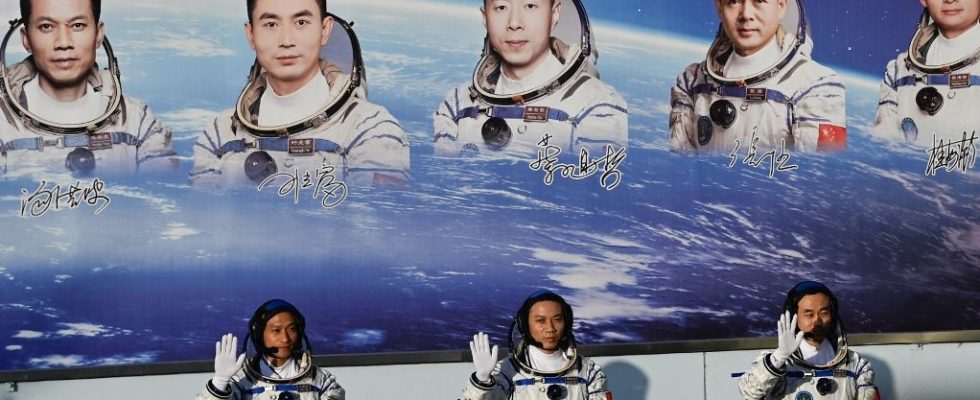China sent its youngest crew of astronauts into space on Thursday to its Tiangong space station, with the ambition of strengthening its knowledge of human spaceflight and setting foot on the lunar surface by 2030.
The Shenzhou-17 mission trio took off aboard a Longue-Marche 2F rocket at 11:14 a.m. local time (03:14 GMT) from the Shenzhou launch center. Jiuquan, in the Gobi Desert (northwest), according to images from state television CCTV.
Its youngest crew
It includes Commander Tang Hongbo, born in October 1975, his colleague Tang Shengjie (33 years old) as well as Jiang Xinlin (35 years old). The average age of the crew is 38 years old, compared to 42 years old during the previous Shenzhou-16 mission.
Hundreds of fans waving the Chinese flag and yellow flowers cheered the three astronauts, dressed in white and blue spacesuits. To the sound of the patriotic song “Ode to the Fatherland”, the space travelers wandered all smiles among the cheering spectators, waving before boarding a bus towards the launch pad. Dozens of space program employees, many of whom live year-round on the immense Jiuquan site, attended the takeoff and then celebrated its success around a Chinese flag.
Direction Tiangong, the Chinese space station
The vessel must dock with the central module of the Tiangong (“Heavenly Palace”) station “around six and a half hours” after takeoff, a spokesperson for the Chinese space program, Lin Xiqiang, said on Wednesday. The astronauts’ stay on Tiangong is expected to last six months.
This experience is valuable for the Asian giant, which aims to send a Chinese person to the Moon by 2030, a major objective of a space program which has been progressing steadily for several decades.
Tiangong, whose construction was completed last year, has since taken its final shape in a T shape. Similar in size to the former Russian Mir station – placed in orbit by the Soviet Union – it is however much larger. smaller than the International Space Station (ISS). Also known as CSS (for “Chinese Space Station” in English), it must remain in Earth orbit for at least 10 years.
Ensuring a continuous Chinese presence in Space
China was partly pushed to build its own station by the United States’ refusal to allow it to participate in the ISS. An American law adopted in 2011 prohibits almost any collaboration between American and Chinese space authorities.
Projects linked to the Chinese “space dream” are multiplying under the presidency of Xi Jinping.
The Asian giant has been investing billions of euros in its military-led space program for several decades, which has enabled it to make up most of its gap with the Americans and Russians.
China sent its first astronaut into space in 2003, and its Tiangong space station has been fully operational since the end of 2022. Crews have been taking turns since then to ensure a continuous presence within the orbiting laboratory, carrying out scientific experiments and testing new technologies.
Set foot on the Moon before 2030
In 2019, a Chinese machine landed on the far side of the Moon. Then, in 2021, China brought a small robot to the surface of Mars. It plans to send a first crew towards the Moon by 2030.
The orbital base of the Tiangong station is equipped with cutting-edge scientific equipment, including the “first cold atomic clock system” for space, according to the Xinhua news agency.
Tiangong is planned to operate in low Earth orbit at an altitude of 400 to 450 kilometers for at least 10 years to enable China to maintain a long-term human presence in space.
Beijing does not plan to use Tiangong for cooperation purposes with other countries on the same scale as the International Space Station, but says it is open to possible collaborations, the scope of which is unknown.

